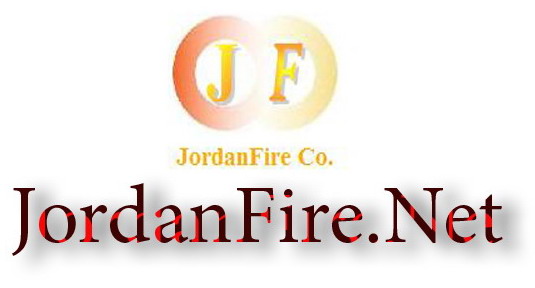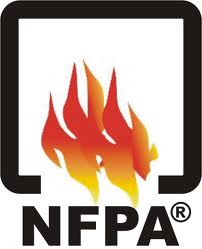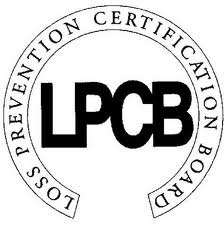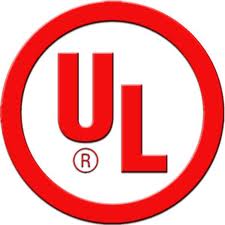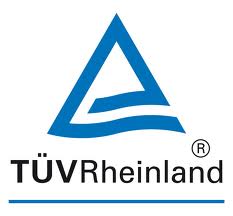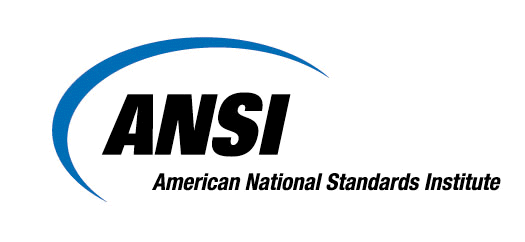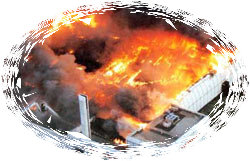
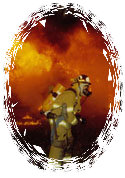


Fire Protection > Fire Extinguishers
A fire extinguisher is an active fire protection device to extinguish or control a fire, often in emergency situations. Typically a fire extinguisher consists of a pressure vessel containing an agent that when discharged, can extinguish a fire .
Markings
Australia
Type pre-1997 current| Water | Solid red | |
| Foam | Solid blue | Red with a blue band |
| Powder | Red with a white band | |
| Carbon dioxide | Red with a black band | |
| Vapourising liquid (not halon) | Red with a yellow band | |
| Halon | Solid yellow | — |
| Wet chemical | Solid oatmeal | Red with an oatmeal band |
United Kingdom
According to the standard BS EN 3, fire extinguishers in the United Kingdom are predominately red, and a band or circle of a second color covering at least 5% of the surface area of the extinguisher indicates the contents. Before 1997, the entire body of the fire extinguisher was colour coded according to the type of extinguishing agent.
Type Old Code BS EN 3 Colour Code Fire Class
| Water | Signal Red | Signal Red | A |
| Foam | Cream | Red with a Cream panel above the operating instructions | A, B and sometimes E |
| Dry Powder | French Blue | Red with a Blue panel above the operating instructions | A, B, C,E |
| Carbon Dioxide CO 2 | Black | Red with a Black panel above the operating instructions | A(Limited),B,E |
| Halon | Emerald Green | No longer produced - illegal in the UK | A,B,E |
| Wet Chemical | Not in use | Red with a Canary Yellow panel above the operating instructions | A, F |
| Graphite Powder | French Blue | Red with a Blue panel above the operating instructions | D |
The UK recognizes six fire classes . Class A fires involve organic solids such as paper and wood. Class B fires involve flammable liquids. Class C fires involve flammable gases. Class D fires involve metals, Class E fires involve live electrical items and Class F fires involve cooking fat and oil. Fire extinguishing capacity is rated by fire class using numbers and letters such as 13A, 55B.
Continental Europe (CEN countries other than UK)
No colour coding imposed : All extinguishers shall be signal red ( RAL 3000). Recently, some voluntary color coding has appeared, however different from the UK National Addendum to EN 3.
United States
There is no official standard in the United States for the color of fire extinguishers, though they are typically red, except for Class D extinguishers, which are usually yellow. Extinguishers are marked with pictograms depicting the types of fires that the extinguisher is approved to fight. In the past, extinguishers were marked with colored geometric symbols, and some extinguishers still use both symbols. No official pictogram exists for Class D extinguishers, though training manuals sometimes show a drill press with shavings burning underneath. The types of fires and additional standards are described in NFPA 10: Standard for Portable Fire Extinguishers.
Fire Class Geometric Symbol Pictogram Intended Use| A | Green Triangle | Garbage can and wood pile burning | Ordinary combustibles |
| B | Pink Square | Gasoline can with a burning puddle | Flammable liquids |
| C | Red Circle | Electric plug with a burning outlet | Energized electrical equipment |
| D | Yellow Star | N/A | Combustible metals |
| K | Black Hexagon | Pan burning | Cooking oils |
The Underwriters Laboratories rate fire extinguishing capacity in accordance with UL/ ANSI 711: Rating and Fire Testing of Fire Extinguishers. The ratings are described using numbers preceding the class letter, such as 1-A:10-B:C. The number preceding the A multiplied by 1.25 gives the equivalent extinguishing capability in gallons of water. The number preceding the B indicates the size of fire in square feet that an ordinary user should be able to extinguish. There is no additional rating for class C, as it only indicates that the extinguishing agent will not conduct electricity, and an extinguisher will never have a rating of just C.
Chemistries
A fire extinguisher may emit a solid, liquid, or gaseous chemical.
Water
Water is the most common chemical for class A fires and is quite effective as one would imagine. Water has a great effect on cooling the fuel surfaces and thereby reducing the pyrolysis rate of the fuel. The gaseous effect is minor for extinguishers, but water fog nozzles used by fire brigades creates water droplets small enough to be able to extinguish flaming gases as well. The smaller the droplets, the bigger the gaseous effect.
Most water based extinguishers also contain traces of other chemicals to prevent the extinguisher rusting. Some also contain surfactants which help the water penetrate deep into the burning material and cling better to steep surfaces.
Water may or may not help extinguishing class B fires. It depends on whether or not the liquid's molecules are polar molecules . If the liquid that is burning is polar (such as alcohol), there won't be any problem. If the liquid is nonpolar (such as large hydrocarbons , like petroleum ), the water will merely spread the flames around.
Similarly, water sprayed on an electrical fire (US: Class C, UK: Class E) will probably cause the operator to receive an electric shock . (However, if the power can be reliably disconnected and a carbon dioxide or halon extinguisher is not available, clean water will actually cause less damage to electrical equipment than will either foam or dry powders). Special spray nozzles, equipped with tiny rotating devices called spiracles will replace the continuous water jet with a succession of droplets, greatly increasing the resistivity of the jet. These shall however be used by skilled personnel, since improper handling of the nozzle may restore continuity of the water jet.
Foams
fighting a petrol fire with a foam extinguisher
Foams are commonly used on class B fires, and are also effective on class A fires. These are mainly water based, with a foaming agent so that the foam can float on top of the burning liquid and break the interaction between the flames and the fuel surface. Ordinary foams are designed to work on nonpolar flammable liquids such as petrol ( gasoline ), but may break down too quickly in polar liquids such as alcohol or glycol . Facilities which handle large amounts of flammable polar liquids use a specialised "alcohol foam" instead. Alcohol foams must be gently "poured" across the burning liquid. If the fire cannot be approached closely enough to do this, they should be sprayed onto an adjacent solid surface so that they run gently onto the burning liquid. Ordinary foams work better if "poured" but it is not critical.
A "protein foam" was used for fire suppression in aviation crashes until the 1960s development of "light water", also known as "Aqueous Film-Forming Foam" (or AFFF ). Carbon dioxide (later sodium bicarbonate) extinguishers were used to knock down the flames and foam used to prevent re-ignition of the fuel fumes. "Foaming the runway" can reduce friction and sparks in a crash landing, and protein foam continued to be used for that purpose, although FAA regulations prohibited reliance upon its use for suppression.
Dry Powder ("Dry Chemical" in the US)
For classes B and C, a dry powder is used. There are two main dry powder chemistries in use:
-
BC powder is either sodium bicarbonate or potassium bicarbonate , finely powdered and propelled by carbon dioxide or nitrogen. Similarly to almost all extinguishing agents the powders acts as a thermal ballast making the flames too cool for the chemical reactions to continue. Some powders also provide a minor chemical inhibition, although this effect is relatively weak. These powders thus provide rapid knockdown of flame fronts, but may not keep the fire suppressed. Consequently, they are often used in conjunction with foam for attacking large class B fires. BC extinguishers are often kept in small vehicles since they provide good knockdown of a rapidly flaring class B fire, from a small package. BC Powder has a slight saponification effect on cooking oils & fats due to its alkalinity & sometimes used to be specified for kitchens prior to the invention of Wet Chemical extinguishers. Where an extremely fast knockdown is required potassium bicarbonate ( Purple K ) extinguishers are used. A particular blend also containing urea ( Monnex ) decrepitates upon exposure to heat increasing the surface area of the powder particles and providing very rapid knockdown.
-
ABC powder is monoammonium phosphate and/or ammonium sulphate . As well as suppressing the flame in the air, it also melts at a low temperature to form a layer of slag which excludes the gas and heat transfer at the fuel surface. For this reason it can also be effective against class A fires. ABC powder is usually the best agent for fires involving multiple classes. However it is less effective against three-dimensional class A fires, or those with a complex or porous structure. Foams or water are better in those cases.
Both types of powders can also be used on electrical fires, but provide a significant cleanup and corrosion problem that is likely to make the electrical equipment unsalvageable.
Wet potassium salts ('Wet Chemical')
Most class F (class K in the US) extinguishers contain a solution of potassium acetate , sometimes with some potassium citrate or potassium bicarbonate. The extinguishers spray the agent out as a fine mist. The mist acts to cool the flame front, while the potassium salts saponify the surface of the burning cooking oil, producing a layer of foam over the surface. This solution thus provides a similar blanketing effect to a foam extinguisher, but with a greater cooling effect. The saponification only works on animal fats and vegetable oils, so class F extinguishers cannot be used for class B fires. The misting also helps to prevent splashing the blazing oil.
Carbon dioxide
Carbon dioxide (CO 2 ) also works on classes B and C/E and works by suffocating the fire. Carbon dioxide will not burn and displaces air. Carbon dioxide can be used on electrical fires because, being a gas, it does not leave residues which might further harm the damaged equipment. (Carbon dioxide can also be used on class A fires when it is important to avoid water damage, but in this application the gas concentration must usually be maintained longer than is possible with a hand-held extinguisher.) Carbon dioxide extinguishers have a horn on the end of the hose. Due to the extreme cold of the carbon dioxide that is expelled from an extinguisher, it should not be touched.
Halons
Halons are very versatile extinguishers. They will extinguish most types of fire except class D & K/F and are highly effective even at quite low concentrations (less than 5%). Halon is a poor extinguisher for Class A fires, a nine pound Halon extinguisher only receives a 1-A rating and tends to be easily deflected by the wind. They are the only fire extinguishing agents that are quite suitable for discharge in aircraft (as other materials pose a corrosion hazard to the aircraft). Halon fire-suppression systems are also incorporated into some armored fighting vehicles , such as the M1 Abrams tank. The major extinguishing effect is by disturbing the thermal balance of the flame, and to a small extent by inhibiting the chemical reaction of the fire. Halons are chlorofluorocarbons causing damage to the ozone layer and are being phased out for more environmentally-friendly alternatives. Halon fire extinguishers may cost upwards of 800 US dollars due to production and import restrictions.
Halon extinguishers used to be widely used in vehicles and computer suites. It is mildly toxic in confined spaces, but to a far less extent than its predecessors such as carbon tetrachloride, chlorobromomethane and methyl bromide.
Since 1992 the sale and service of Halon extinguishers has been made illegal in Canada, except for in a few rare cases.
In the UK and Europe Halons were made illegal at the end of 2003, except for certain specific aircraft and law enforcement uses. This appears to be at least partially in response to the Montreal Protocol and effort by the United Nations Environment Programme ( UNEP ) to combat release of quantities of harmful chemicals into the atmosphere.
Phosphorous tribromide
Like Halon, phosphorous tribromide is a flame chemistry poison, marketed under the brand name PhostrEx . PhostrEx is a liquid which needs a propellant, such as compressed nitrogen and/or helium, to disperse onto a fire. As a fire extinguisher PhostrEx is much more potent than Halon making it particularly appealing for aviation use as a lightweight substitute. Unlike Halon, PhostrEx reacts quickly with atmospheric moisture to break down into phosphorus acid and hydrogen bromide , neither of which harm the earth's ozone layer.
High concentrations of PhostrEx can cause skin blistering and eye irritation, but since so little is needed to put out flames this problem is not a significant risk, especially in applications where dispersal is confined within an engine compartment. Any skin or eye contact with PhostrEx should be rinsed with ordinary water as soon as practical. PhostrEx is not especially corrosive to metals, although it can tarnish some. The U.S. EPA and FAA both approved PhostrEx, and the substance will find its first major use in Eclipse Aviation 's jet aircraft as an engine fire suppression system
Fluorocarbons
Recently, DuPont has begun marketing several nearly saturated fluorocarbons under the trademarks FE-13, FE-25, FE-36, FE-227, and FE-241. These materials are claimed to have all the advantageous properties of halons, but lower toxicity, and zero ozone depletion potential. They require about 50% greater concentration for equivalent fire quenching.
Specialised materials for Class D
Class D fires involve extremely high temperatures and highly reactive fuels. For example, burning magnesium metal breaks water down to hydrogen gas and causes an explosion; breaks halon down to toxic phosgene and fluorophosgene and may cause a rapid phase transition explosion ; and continues to burn even when completely smothered by nitrogen gas or carbon dioxide (in the latter case, also producing toxic carbon monoxide ). Consequently, there is no one type of extinguisher agent that is approved for all class D fires; rather, there are several common types and a few rarer ones, and each must be compatibility approved for the particular hazard being guarded. Additionally, there are important differences in the way each one is operated, so the operators must receive special training. Some example class D chemistries include:
-
Finely granulated sodium chloride and graphite applied by a shaker, scoop or shovel. Suitable for sodium , potassium , magnesium, titanium , aluminium , and most other metal fires.
-
Finely powdered graphite, applied with a long handled scoop, is preferred for fires in fine powders of reactive metals, where the blast of pressure from an extinguisher may stir up the powder and cause a dust explosion . Graphite both smothers the fire and conducts away heat.
-
Finely powdered copper propelled by compressed argon is the currently preferred method for lithium fires. It smothers the fire, dilutes the fuel, and conducts away heat. It is capable of clinging to dripping molten lithium on vertical surfaces. Graphite can also be used on lithium fires but only on a level surface.
-
Other materials sometimes used include powdered sodium carbonate , powdered dolomite and argon gas.
-
As a very poor last resort dry sand may be used to smother a metal fire if nothing else is available, applied with a long-handled shovel to avoid the operator receiving flash burns. Sand is, however, notorious for collecting moisture, and even the smallest trace of moisture may result in a steam explosion, spattering burning molten metal around.
Fitment
Fire extinguishers are typically fitted in buildings at an easily-accessible location, such as against a wall in a high-traffic area. They are also often fitted to passenger cars , and are required fitment for most forms of motor sport .
Maintenance
Most countries in the world require regular maintenance by a competent person to operate safely and effectively, as part of fire safety legislation. Lack of maintenance can lead to an extinguisher not discharging when required, or rupturing when pressurized. Deaths have occurred, even in recent times, from corroded extinguishers exploding.
There is no all-encompassing fire code in the United States. Generally, most municipalities (by adoption of the International Fire Code ) require inspections every 30 days to ensure the unit is pressurized and unobstructed (done by an employee of the facility) and an annual inspection by a qualified technician. A 5 yearly hydraulic pressure testing for all types of extinguisher is also required.
Recently the National Fire Protection Association and ICC voted to allow for the elimination of the 30 day inspection requirement so long as the fire extinguisher is monitored electronically . According to NFPA, the system must provide record keeping in the form of an electronic event log at the control panel. The system must also constantly monitor an extinguisher's physical presence, internal pressure and whether there's an obstruction that could prevent ready access. In the event that any of the above conditions are found to be compromised, the system must send an alert to officials so they can immediately rectify the situation. Electronic monitoring can be wired or wireless.
In the UK, three types of maintenance are required:
-
Basic Service: All types of extinguisher require a basic inspection annually to check weight, correct pressure (using a special tool, not just looking at the gauge) & for signs of damage or corrosion;
-
Extended Service: Water, Wet Chemical, Foam & Powder extinguishers require every 5 years a more detailed examination including a test discharge of the extinguisher & recharging if satisfactory;
-
Overhaul: CO 2 extinguishers, due to their high operating pressure, are subject to pressure vessel safety legislation and must be hydraulic pressure tested & date stamped every 10 years.
Which Extinguisher should i use :

Sources:
NFPA 1 Fire prevention code
Uniform fire code 1997
Retrieved from " Wikipedia "
